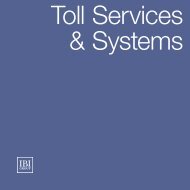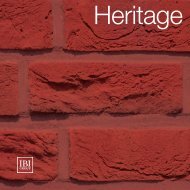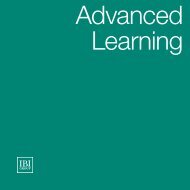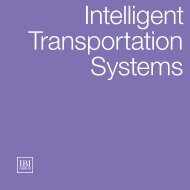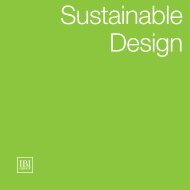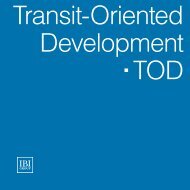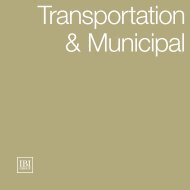Sense Sensitive Design - IBI Group
Sense Sensitive Design - IBI Group
Sense Sensitive Design - IBI Group
You also want an ePaper? Increase the reach of your titles
YUMPU automatically turns print PDFs into web optimized ePapers that Google loves.
Facilities | sense sensitive <strong>Design</strong> 11<br />
Understanding of the sense of balance and this sensory<br />
receptor in the healthcare environment is vital. The<br />
sick, very young, the disabled, the elderly, the partially<br />
sighted and the blind will all rely heavily on their own<br />
sense of balance. It is crucial that the environment must<br />
be perpetually true and honest in terms of vertical and<br />
horizontal plains. A sudden change in floor finish from light<br />
to dark may feel like a chasm to certain patient groups.<br />
Variable height furniture, fittings and sanitary ware helps<br />
further support the patient.<br />
By working with the above set criteria in mind, it is possible<br />
to create environments that have the most positive effect<br />
on the patient’s well-being.<br />
Smells are retained more acutely in our memory than<br />
are visual images or sounds. <strong>Design</strong>ers have a real<br />
opportunity to affect people’s moods, perceptions and<br />
motivation through smells and fragrances. Unpleasant<br />
odours increase heart rates. One forgets that some of the<br />
smells that inhabit hospitals are formaldehyde, formulin,<br />
iodine, glutaraldehyde, bone, dust, urine, burnt skin/ hair,<br />
testosterone, disease, body odour etc. Fear per se is<br />
communicated through smells. Good ventilation systems<br />
are sufficient to remove these smells. Smells can also relax<br />
muscles and aid concentrating. Kajima- a contracting<br />
firm - has coupled up with Shiseido - a perfume<br />
manufacturer - to produce a unique air conditioning<br />
system in the Kajima HQ in Tokyo. The system emits citrus<br />
smells that invigorate staff early in the morning followed<br />
by floral smells that aid concentration and then woodland<br />
smells at lunchtime to relax. The same cycle commences<br />
after lunch. In a healthcare environment ‘baby smells’<br />
can reduce aggression in Accident and Emergency Units.<br />
Vanilla fragrances encourage per-term babies to feed in<br />
the Neonatal Intensive Care Unit (NICU’s). Pleasant smells<br />
help the body produce endorphins, the body’s natural<br />
‘feel good’ drug, which in itself may reduce the amount of<br />
anaesthetic administered during a surgical procedure.




